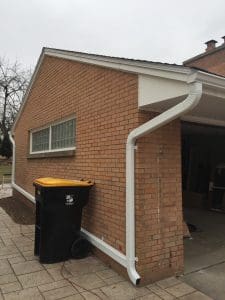Water can cause damage to homes but a well-designed gutters can be a solution. How your gutter professional designs the flow of your gutters can mean the difference between having water in your basement or staying dry.
Here’s a list of a few things that your gutter professional should always be looking at.
- Identify the slope of the property as it relates to the house
- Water flows downhill
- Strategically locate downspouts in places where surface water will drain away
- Minimize or eliminate water flows with surface drainage is not optimal
- Note the height of the fascia to see if a gutter drop will allow for a pitched gutter
- Evaluate the gutter apron to see if it is sufficient
- Identify homeowner traffic patterns
- Reduce or eliminate downspout spill areas that could contribute toward ice or mud problems
In the case where a yard has very little or no slope next to a house, you’ll want to make sure that you move the water to a part of the property where the water cannot damage the home.

Concrete right behind this house, combined with a flat slope in the back, made spilling toward the front of the house, where there was a slope, optimal.
In the photo you will note a few things going on that would not be obvious to the casual observer.
- We were able to move the water from the back of the house to the front of the house by putting the downspout on the side instead of the back of the house.
- That water was then carried toward the front by a sloped downspout.
- The front of the house had a good drop off where surface water will run away from the foundation.
- The downspout that serves the front of the house goes straight down, reducing the chances of ice buildup and downspout splitting at elbows in the winter.
- We tapped in the horizontal downspout into the downspout that serves the front. This will reduce an additional downspout spilling onto the concrete. Excessive flow onto concrete could damage the concrete.
- Placement of the horizontal downspout was above the wheels of the recycle and garbage cart but below the hinge of the cart. The location of the carts will not change.
- By using larger (3″x4″) downspouts, we were able to accommodate larger rainfall flows common from storms in the midwest.
- We combined the flow from two downspouts into one. Now the homeowner can choose to connect a small flexible hose that goes across the 2-1/2 foot sidewalk. This allows water to spill on the grass instead of the sidewalk.
Posted in Gutters, Water Hydrology

